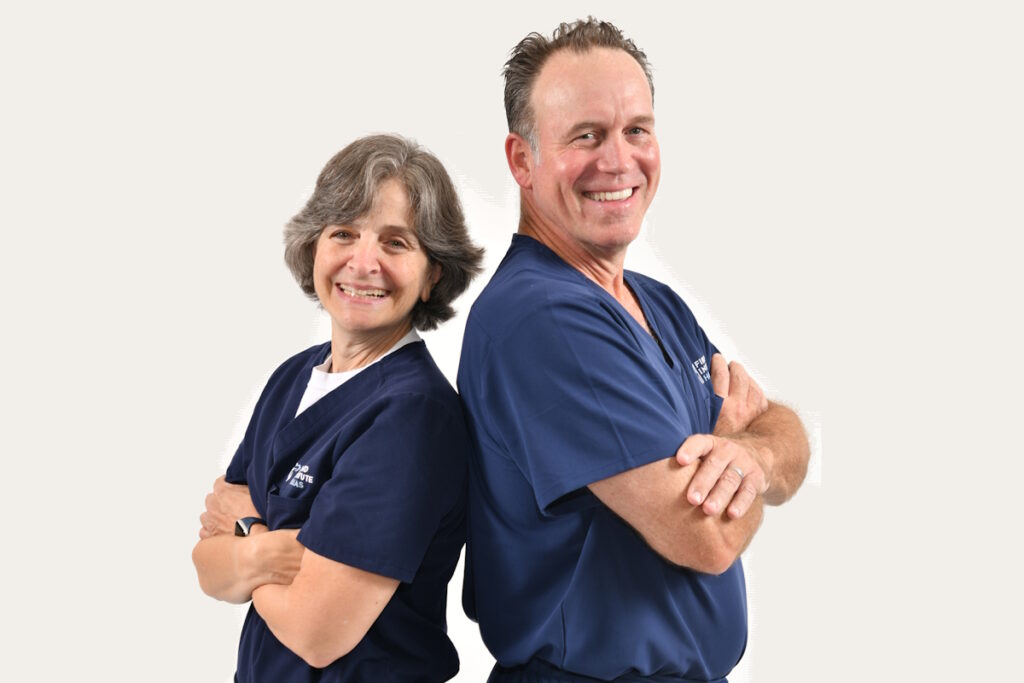When Jessica’s gynecologist confirmed that her heavier-than-normal periods and uncomfortable low back pain were because of fibroids, she naturally had a ton of questions. On the one hand, she was relieved to know why she was in pain and that she could be pain-free again. But she also had concerns about uterine fibroid treatment. What will her OBGYN do to treat her fibroids exactly? Will she be referred to another doctor? The answer to Jessica’s question lies in what she and her gynecologist feel is the best course of action for her unique situation.
For uterine fibroid treatment initially an OBGYN may suggest a variety of conservative methods to see if symptoms improve. If those do not work for the patient and/or symptoms persist, gynecologists can perform fibroid removal with a hysterectomy or myomectomy. But suppose a patient doesn’t want fibroid surgery or can’t for health reasons. The good news is there are less-invasive options like Uterine Fibroid Embolization (UFE), though that would require a different type of doctor.
The UFE treatment option is performed by interventional radiologists, not gynecologists. The UFE procedure shrinks fibroids rather than surgically removing them. By doing so, a woman can avoid a messy and painful surgery and still eliminate period problems caused by fibroid symptoms, such as:
- Heavy menstrual bleeding
- Periods that last longer than a week
- Debilitating cramps, pelvic pain, and pressure
- Pain during sex
- Back or leg pain
- Urinary frequency
- Bowel or bladder dysfunction
- Excessive fatigue
- Bloating and swelling
- Weight gain from fibroids
Is Fibroid Removal or Treatment Necessary?
Just because you have fibroids doesn’t mean they need to be treated. In cases where patients have asymptomatic fibroids, and there isn’t concern for other complications, their OBGYN might recommend a “wait and see” approach. Fibroids come in all shapes and sizes. While some do cause discomfort, it is not always the case. And this is an acceptable answer.
On the other hand, if you start noticing changes in your menstrual cycle that aren’t what you’re used to, or you begin experiencing pain and symptoms like those mentioned above, you may want to consider seeking some form of treatment. Your OBGYN can suggest a variety of options for fibroid removal or treatment.
Initial Uterine Fibroid Treatment Options Your OBGYN May Recommend
Treating Fibroids with Hormonal IUDs
IUDs come in two forms (hormonal and non-hormonal) and have long been used by women to prevent pregnancy. They are incredibly effective, too, with fewer than 1 out of 100 women who use them getting pregnant each year. But another benefit to IUDs is their ability to decrease fibroid symptoms. This is only true with hormonal IUDs, which release a tiny amount of a synthetic hormone called progestin that has been shown in some cases to help with fibroid symptoms because it thickens your cervical mucus and thins the uterine lining.
There is no proof that this will work 100% of the time, and there is a chance that a hormonal IUD can make your fibroids grow. But it is a treatment option your OBGYN can discuss with you.
Treating Fibroids with Oral Contraceptives
Oral contraceptives can regulate the menstrual cycle and stop spotting between periods or continual bleeding. They can also sometimes reduce the volume of menstrual flow. However, oral contraceptives will not shrink fibroids. They also carry several risks for older women and women who smoke.

Treating Fibroids with Medications
Non-steroidal anti-inflammatory drugs (NSAIDs) such as aspirin, ibuprofen, and naproxen are commonly used to treat cramping pain associated with menstruation and fibroids. And for many women, they absolutely do the trick when trying to manage mild to moderate fibroid symptoms. This is because NSAIDs block the inflammatory process and uterine contractions responsible for menstrual cramps.
NSAIDs are so effective at relieving menstrual cramps that pressure was put on the FDA to release ibuprofen over the counter in the 1970s so that more women could use it.
Initial Treatments Didn’t Work. What Are My Options Now?
If you want to explore other uterine fibroid treatment options, there are alternatives. Be prepared that your OBGYN may recommend fibroid surgery—and this is something your gynecologist can provide for you. Or you may receive a referral from your OBGYN to seek help from an interventional radiologist.
Treating Fibroids with Hysterectomy
If fibroid surgery is recommended, that includes hysterectomy. Approximately 600,000 hysterectomies are performed annually in the United States. This is an extremely invasive and bloody procedure that ultimately removes all or part of a woman’s uterus. In some cases, her fallopian tubes and ovaries will also be removed. Your OBGYN might recommend a hysterectomy because it’s the only option in some cases. For example, you could have invasive cancer of the uterus, ovaries, or cervix, or you could have uncontrollable bleeding.
If your OBGYN recommends a hysterectomy, and you decide to do it, it can be performed in several ways.
- Vaginal Hysterectomy — In this procedure the uterus is surgically removed through the vagina. Your OBGYN will detach the uterus from the ovaries, fallopian tubes and upper vagina, as well as from the blood vessels and connective tissue that support it, before removing the uterus. One or both ovaries and fallopian tubes may be removed during the procedure as well
- Laparoscopic Hysterectomy — Your OBGYN will make a small incision either in the abdomen or vagina. From there, they’ll place a thin, lighted tube and small camera inside to laparoscopically remove the uterus.
- Robotic Hysterectomy — Similar to a laparoscopic hysterectomy, your doctor performs the surgery using a robotic arm.
- Abdominal Hysterectomy — Another option is to make an incision in the lower abdomen and manually perform the surgery.

Treating Fibroids with Myomectomy
Another surgical option performed by an OBGYN is a myomectomy, which removes fibroids while leaving the uterus in place. Approximately 30,000 myomectomy surgeries happen each year, and they are generally recommended to women who need relief from painful fibroids but still want to get pregnant. As your OBGYN will explain, you won’t be able to have children after a hysterectomy.
There are three types of myomectomies:
- Hysteroscopic Myomectomy — This procedure is only appropriate for patients whose fibroids are located in the uterine cavity. Your surgeon will use a thin, telescopic tube to access the uterine cavity before lifting the walls of the uterus to shave off the fibroids. The recovery time is about a week.
- Laparoscopic Myomectomy — Only four tiny incisions to the abdominal area are needed to access the uterus, and recovery time is roughly two to four weeks depending on the technique. Patients who have large fibroids embedded deep in the uterine wall will not benefit from this procedure.
- Abdominal Myomectomy — This is by far the most invasive of the three myomectomy procedural options and requires a longer incision in the lower abdominal region and in the area of the uterus where the fibroids are located. Your doctor won’t be as limited with abdominal myomectomies, as they can safely remove deeply embedded fibroids as well as those that are excessively large or in large quantities.
I Want to Avoid Surgery. What Are Other Fibroid Treatments?
Treating Fibroids with UFE
The UFE (Uterine Fibroid Embolization) procedure is unique because it doesn’t remove uterine fibroids in the way surgery does. It is also performed by an interventional radiologist, not your OBGYN. But it is an easier, safer, low-risk procedure for fibroid treatment because it cuts off blood flow to all fibroids, causing them to shrink and die.
During UFE, small particles are injected through a tiny catheter at the wrist. They are introduced through the uterine arteries into the fibroid vessels, blocking the blood flow to the fibroids. The procedure will last about one hour, and you will be asleep for the procedure. You can resume light activities as soon as you feel up to it.
Advantages of UFE at Fibroid Institute include:
- No hospital stay
- Recovery time only 7-10 days
- No abdominal (belly) incision
- Tiny wrist puncture
- No blood loss or scarring
- Treat multiple fibroids at once
- Uterus is spared
- Covered by most medical insurance
- >90% improvement in fibroid symptoms
UFE is perfect for women who want to avoid surgery, keep their uterus, and enjoy a shorter recovery time. It also comes in handy for women who can’t have fibroid surgery because their OBGYN considers them a technically challenging case.

5-Star Uterine Fibroid Treatment at Fibroid Institute
Fibroid Institute Texas is your go-to source for educating patients about uterine fibroids and minimally invasive procedures such as Uterine Fibroid Embolization. Thousands of women have had their fibroids symptoms treated with UFE. Even if a hysterectomy or myomectomy is the recommended course of action by your OBGYN, UFE can be used as a pre-surgical procedure to make your experience as seamless and successful as possible.
Uterine Fibroid Embolization (UFE) is the gold standard in non-surgical uterine fibroid treatment. Dr. Suzanne Slonim at our Dallas fibroid clinics and Dr. John Fischer at our Houston fibroid clinics are the top fibroid experts you need in your corner. The fibroid specialists are 100% fibroid focused. When it comes to fibroid treatment with UFE, experience matters.
Most major medical insurance providers cover the cost of UFE. You will need a formal consultation to determine if you are a candidate before scheduling your procedure. Call for a telehealth consult or an in-office appointment in Dallas at 214-838-6440 or Houston at 713-903-3733 or complete the form below.
"*" indicates required fields
This information is not a substitute for professional medical advice. Prior to starting any new treatment or if you have questions regarding a medical condition, always seek the advice of your doctor or other qualified health provider.
Fibroid Institute Dallas serves the DFW area including North Dallas, Highland Park, University Park, Park Cities, Garland, Mesquite, Richardson, Dallas, Addison, Carrollton, Plano, Frisco, McKinney, Allen, Fort Worth, Grand Prairie, HEB, Arlington, Hutchins, Irving, Duncanville, DeSoto, Cedar Hill, Lancaster, Cockrell Hill, and all of North Texas.

